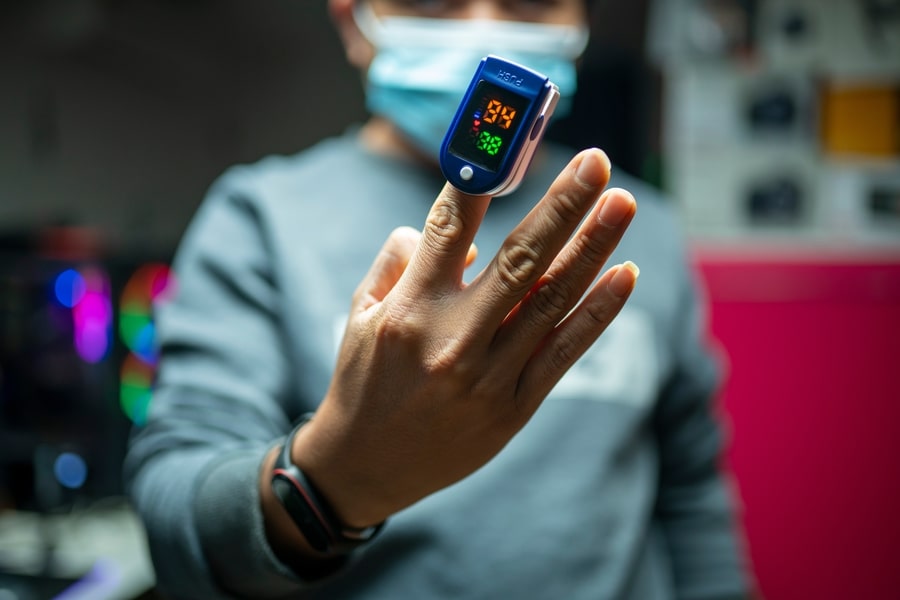Has your doctor told you to use a pulse oximeter at home to track your blood oxygen levels, or do you feel like you need one? If the answer is yes, you'll find it helpful to know how it works and how to read a pulse oximeter. That's why we prepared this guide for you. Learn what you need to know about it and observe the oxygen saturation of your blood the right way.
What Is Pulse Oximeter?
Pulse oximetry is a test that measures the oxygen saturation level of your blood. It can quickly discover even small changes in these levels. They indicate if your lungs and heart function properly and how efficiently blood is transporting oxygen to the extremities furthest from your heart.
The pulse oximeter is a small, clip-like device attaching to a body part, usually a finger, and sometimes a toe or earlobe. Doctors often use them in critical care environments, but some may use them in an office. Sometimes they advise their patients to use a pulse oximeter at home too. These people usually have conditions affecting their oxygen levels, such as chronic heart or lung conditions and COVID-19.
The Purpose of Pulse Oximetry
Doctors may use pulse oximeters to observe the health of people with conditions affecting blood oxygen levels, such as:
- Asthma
- Pneumonia
- Chronic obstructive pulmonary disease (COPD)
- Lung cancer
- Heart failure or heart attack
- Congenital heart disease
- Anemia
They use them for other purposes too:
- To assess how well a lung drug is working
- To observe oxygen levels during or after particular surgeries
- To understand whether a patient needs oxygen therapy and how effective it is
- To assess if someone needs help breathing
- To evaluate a person's ability to tolerate physical activity
How to Take a Pulse Oximetry Reading
Your doctor may have recommended that you use a pulse oximeter at home. To get the most accurate pulse oximetry reading, follow the steps below.
- Set the probe correctly - depending on the pulse oximeter that will typically be on the finger, toes, or earlobe. Ensure it fits well. If it's too tight or too loose, it can let extra light in, which will affect the reading.
- Sit still. Shivering or shaking will impact the reading and can make it appear lower than it is.
- Remove nail polish. If you don't, it can impact the reading. Tattoos and henna dye can also affect it. So, choose the finger, toe, or earlobe without it.
- Keep the pulse oximeter on for as long as needed to observe your oxygen saturation and pulse.
- Remove it once the test ends.
In pulse oximetry, tiny beams of light pass through the blood, measuring the amount of oxygen. A pulse oximeter does this by measuring changes in light absorption in oxygenated or deoxygenated blood, and the process is painless.
There are various pulse oximeters coming with different features and prices. A comparison between the standard and pocket pulse oximeter accuracy showed that the standard version had a precision error of 1.8%, whereas the pocket oximeter had an error of 2.21%. So, keep that in mind before buying yours.
How to Read a Pulse Oximeter?

Pulse oximetry readings estimate blood oxygen levels, but they are generally accurate, especially when using high-quality devices. More than 89% of your blood should be carrying oxygen, and this is the saturation level required to keep your cells healthy and functioning.
Oxygen saturation below this level may not cause damage, but only if it's temporary. However, having consistent low oxygen levels can be detrimental and indicate blocked airways, difficulty breathing, lung infection, poor blood circulation, etc. Moreover, if your reading drops during exercise, it can indicate heart or lung condition.
An oxygen saturation level of 95% to 100% is typical for most healthy individuals. However, levels lower than 92% can suggest potential hypoxemia.
Many factors can impact pulse oximetry readings, such as skin tone. A report compared the accuracy of pulse oximetry tests and blood gas measurements in detecting hypoxemia in white and black patients. Researchers discovered that there were three times more cases of tests failing to detect hypoxemia among black individuals than blood gas measurements.
Who Should Use a Pulse Oximeter?
A pulse oximeter estimates the oxygen saturation of your blood, with 100% being the ideal level. And, although this medical device is available in many pharmacies, many people don't need it. If you don't have a chronic lung or heart condition, you likely won't need one at your home, but that doesn't mean you can't have one just in case.
However, if you have heart or lung conditions, such as COPD or heart failure, your doctor will likely prescribe home oxygen therapy. And a pulse oximeter can help see if the treatment improves your condition.
In addition, pulse oximeters are used to point out severe cases of COVID-19 because this infection can decrease blood oxygen levels. However, if that happens, you'll probably notice other symptoms before using a pulse oximeter. Oxygen saturation alone isn't the only indicator of health conditions, so tell your doctor about other symptoms as well.
Other signs of low blood oxygen levels can include:
- Increased heart or breathing rate.
- Shortness of breath.
- Lack of ability to do activities you could do before without getting out of breath.
It's best not to rely on pulse oximeter readings alone for everyday health. These numbers are only estimations of your blood oxygen levels and should be taken in context.
When Should I Call the Doctor?

Your doctor likely told you what numbers to watch for when using a pulse oximeter. If not, here's some advice - if your blood oxygen level drops below 95%, even it happens just when you're active, you should contact your doctor.
If you have health conditions like COPD, your blood oxygen level may consistently be lower than 95%. So, check with your doctor what numbers you should expect when you use a pulse oximeter and which one is an indication you need medical help. In addition, call your medical professional if your symptoms get worse or you aren't getting better.
Get Your Pulse Oximeter
If you have a health condition requiring you to use a pulse oximeter or feel like you need one, try Pulse Oxi+. It's an accurate, simple-to-use device that easily fits into your pocket or purse. Get results fast and track your blood oxygen levels to stay safe and healthy.